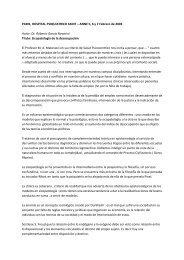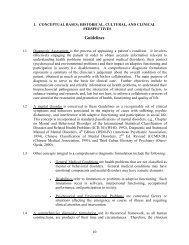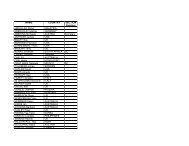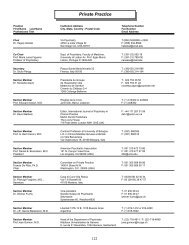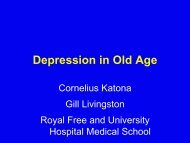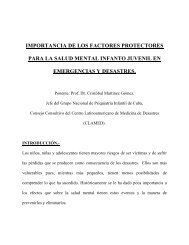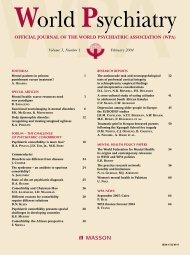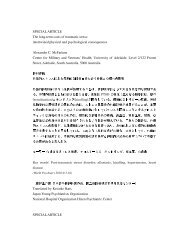ABSTRACTS - World Psychiatric Association
ABSTRACTS - World Psychiatric Association
ABSTRACTS - World Psychiatric Association
You also want an ePaper? Increase the reach of your titles
YUMPU automatically turns print PDFs into web optimized ePapers that Google loves.
gradually distanced the community and even the relatives from care<br />
of patients. The establishment of a directorate of community mental<br />
health services in 2006 by the hospital management resulted in the<br />
articulation of a community mental health programme for the hospital.<br />
The programme, which includes intensive media (television) as<br />
well as face-to-face mental health education and information campaigns,<br />
from July 2007 is at an early phase of implementation. There<br />
is active education of existing service users and relatives on the benefits<br />
of use of services close to their place of residence. We found<br />
increased service utilisation related to increased mental health awareness<br />
and a trend towards appropriate service utilisation following<br />
commencement of community programme. Mental health professionals<br />
need to shift from mental hospital based practice to service provision<br />
in the community and for the existing federal neuropsychiatric<br />
hospitals to make definite commitments towards development of<br />
community mental health services in their zones.<br />
ZS6.3.<br />
MEDICATION ADHERENCE IN NIGERIAN<br />
PSYCHIATRIC OUTPATIENT CLINICS<br />
A. Adewuya<br />
Department of Psychiatry, Lagos State University Teaching<br />
Hospital, Ikeja, Lagos, Nigeria<br />
The aims of this study were to assess the rate of adherence to medications<br />
amongst psychiatric outpatients in Nigeria and examine factors<br />
associated with medication non-adherence amongst this group. <strong>Psychiatric</strong><br />
outpatients (n=342) from three centres were assessed for<br />
medication adherence using the Morisky Medication Adherence<br />
Questionnaire. Details regarding sociodemographic variables (age,<br />
sex, education, religion, marital status, employment, income, medication<br />
cost), illness related variables (diagnosis, duration, number of<br />
episodes/admissions, insight, severity of symptoms, mental state,<br />
functional status), medication related variables (type, mode of administration,<br />
side effects, attitudes to medication) and perception related<br />
variables (self-stigma, perceived causation and prognosis) were also<br />
obtained. There were 76 (22.2%) participants with good medication<br />
adherence, 102 (29.8%) with moderate adherence and 164 (48.0%)<br />
with poor adherence. The significant independent correlates of poor<br />
medication adherence included being employed (OR 3.42; 95% CI<br />
2.17-5.39), poor social support (OR 5.86; 95% CI 2.87-12.17), high<br />
self-stigma (OR 4.70; 95% CI 2.24-9.96) and perceived spiritual causation<br />
of mental illness (OR 3.74; 95% CI 1.87-7.74). The majority of<br />
psychiatric outpatients in south-western Nigeria had poor medication<br />
adherence. Our findings stress the importance of patients’ perception<br />
and social environment in determining treatment adherence and the<br />
necessity of educating the patient. Clinicians’ attention to psychological<br />
barriers early in treatment may improve medication adherence<br />
and ultimately affect the course of illness.<br />
ZS6.4.<br />
IMPACT OF ATYPICAL AND CONVENTIONAL<br />
ANTIPSYCHOTICS ON THE QUALITY OF LIFE<br />
OF PATIENTS WITH SCHIZOPHRENIA:<br />
A PRELIMINARY REPORT FROM LAGOS<br />
TEACHING HOSPITALS<br />
A. Erinfolami, B. Ola, A. Olagunju<br />
Department of Psychiatry, University of Lagos; Department of<br />
Psychiatry, Lagos State College of Medicine, Ikeja, Lagos, Nigeria<br />
In sub-Saharan Africa, the use of atypical antipsychotics is still limited,<br />
because of their prices and availability. Studies addressing the<br />
impact of different antipsychotic therapies on the subjective quality of<br />
life of African schizophrenic patients are few. This study seeks to<br />
compare the subjective quality of life of schizophrenic patients treated<br />
with either conventional or atypical antipsychotics. One hundred<br />
patients meeting ICD-10 criteria for the diagnosis of schizophrenia<br />
were included in this two-centre study. In each centre, 20 schizophrenic<br />
patients were treated with haloperidol, 15 with risperidone<br />
and 15 with olanzapine for a 6-week period. The symptomatology of<br />
the patients was assessed using the Positive and Negative Syndrome<br />
Scale (PANSS); quality of life was assessed by the WHOQoL-BREF.<br />
The atypical antipsychotic group had significantly higher scores in<br />
general quality of life as well as in different life domains: physical<br />
health, environment, psychological and social relationship in everyday<br />
life. In the individual comparisons of the atypical and conventional<br />
antipsychotics, patients on olanzapine or risperidone had higher<br />
quality of life scores than patients on haloperidol.<br />
ZS7.<br />
MOOD DISORDERS IN IRAN: AN UPDATE<br />
(organized by the WPA Central and Western Asia<br />
Zone)<br />
ZS7.1.<br />
A BIBLIOMETRIC ANALYSIS OF RESEARCH<br />
ON MOOD DISORDERS IN IRAN<br />
M. Amin Esmaeili, S.S. Gudarzi, N. Mahdavi<br />
Mood Disorder Section, Iranian <strong>Psychiatric</strong> <strong>Association</strong><br />
The studies on the burden of disease in Iran revealed that psychiatric<br />
disorders ranked the second among all medical illnesses. Depressive<br />
disorders were shown to be the most disabling disease among<br />
women. To define a prospective view of the studies on mood disorders<br />
in Iran, we performed a bibliometric study on the relevant literature.<br />
All the papers from Iran which were published in the national<br />
and international scientific journals were assessed. Two Iranian databases,<br />
Iranmedex and Iranpsych, and two International databases,<br />
Medline and Embase, were searched. All the articles were assessed by<br />
three psychiatrists with good inter-rater reliability. In total, 973 articles<br />
achieved the inclusion criteria. The subject of articles was depressive<br />
disorder (78.4%), bipolar disorder (7.8%) and suicide (10.2%).<br />
An increasing trend in publications on mood disorders in Iran was<br />
found. Most of the studies have targeted depressive disorders. The<br />
most substantial increase was found in epidemiological studies (representing<br />
53.8% of the total). The methodology of the studies was<br />
descriptive in 32.8% of cases, descriptive/analytic in 39.5% and analytic<br />
in 28%. An increase in published research on bipolar disorders<br />
has only started since 2000. The rate of publications in international<br />
journals has shown a sharp increase since 2000. Nevertheless, considering<br />
the prevalence of mood disorders in Iran, the whole scientific<br />
output remains insufficient.<br />
ZS7.2.<br />
DEPRESSION IN THE IRANIAN CULTURAL<br />
CONTEXT<br />
H. Davidian<br />
University of Tehran, Iran<br />
The prevalence of depressive disorders in the general population in<br />
Iran is about 10%. About 10% of the patients seen by general practitioners<br />
suffer from depression, 50% of whom remain undiagnosed. 30-<br />
60% of the patients admitted to general hospitals for physical illnesses<br />
125




